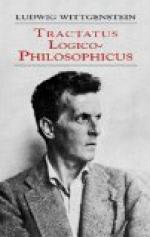2.05 The totality of existing states of affairs also determines which states of affairs do not exist.
2.06 The existence and non-existence of states of affairs is reality. (We call the existence of states of affairs a positive fact, and their non-existence a negative fact.)
2.061 States of affairs are independent of one another.
2.062 From the existence or non-existence of one state of affairs it is impossible to infer the existence or non-existence of another.
2.063 The sum-total of reality is the world.
2.1 We picture facts to ourselves.
2.11 A picture presents a situation in logical space, the existence and non-existence of states of affairs.
2.12 A picture is a model of reality.
2.13 In a picture objects have the elements of the picture corresponding to them.
2.131 In a picture the elements of the picture are the representatives of objects.
2.14 What constitutes a picture is that its elements are related to one another in a determinate way.
2.141 A picture is a fact.
2.15 The fact that the elements of a picture are related to one another in a determinate way represents that things are related to one another in the same way. Let us call this connexion of its elements the structure of the picture, and let us call the possibility of this structure the pictorial form of the picture.
2.151 Pictorial form is the possibility that things are related to one another in the same way as the elements of the picture.
2.1511 That is how a picture is attached to reality; it reaches right out to it.
2.1512 It is laid against reality like a measure.
2.15121 Only the end-points of the graduating lines actually touch the object that is to be measured.
2.1514 So a picture, conceived in this way, also includes the pictorial relationship, which makes it into a picture.
2.1515 These correlations are, as it were, the feelers of the picture’s elements, with which the picture touches reality.
2.16 If a fact is to be a picture, it must have something in common with what it depicts.
2.161 There must be something identical in a picture and what it depicts, to enable the one to be a picture of the other at all.
2.17 What a picture must have in common with reality, in order to be able to depict it—correctly or incorrectly—in the way that it does, is its pictorial form.
2.171 A picture can depict any reality whose form it has. A spatial picture can depict anything spatial, a coloured one anything coloured, etc.
2.172 A picture cannot, however, depict its pictorial form: it displays it.
2.173 A picture represents its subject from a position outside it. (Its standpoint is its representational form.) That is why a picture represents its subject correctly or incorrectly.
2.174 A picture cannot, however, place itself outside its representational form.




